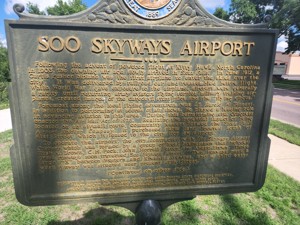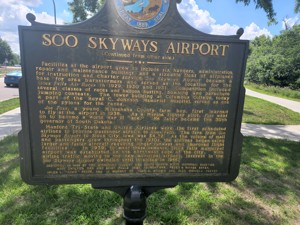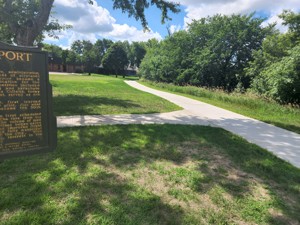“Soo Skyways Airport”

(Note: any text in italics has been taken from the official SDSHS records.)
Subject
A place. The first airport in Sioux Falls.
Marker Text
Following the advent of powered flight at Kitty Hawk, North Carolina in 1903, the dawning air age slowly arrived in Sioux Falls. In June 1912, a Curtis Pusher biplane was the first airplane to enter the skies over the city. It was delivered by railroad car and reassembled before flight.
While World War I gave exposure to the airplane, aircraft were generally a rarity until returning army aviators flying surplus military training airplanes, created images of the daredevil stunt pilot and the ‘flying circus.'
Foremost among the local flying adventurers was Lt. Harold W. Tennant. In addition to performing at scores of air shows, he played a leading role in advancing aviation in this area. During this barnstorming era, Congress enacted the Air Mail Act of 1925. Realizing the potential impact of being located on an airmail route, community leaders formed the Sioux Falls Airport Holding Company. It purchased farm land located south of 41st Street which it leased to the city for an airport.
To operate the airport, the city contracted with Soo Skyways Airport Company which was formed by a group of local businessmen that included Rush A. Brown, C.H. Peck, John Morrell Foster, and Knapp Brown. Three grass runways soon traversed Soo Skyways Airport. Two runways made a large ‘X’ between Western and Kiwanis Avenues, and a third east-west runway was situated near present 49th Street. Facilities at the airport grew to include six hangars, administration, repair and maintenance buildings, ad a sizeable fleet of airplanes for instruction and charter service. Soo Skyways Airport became a base for area barnstormers and served as the location for the Sioux Falls Air Races in 1929, 1930 and 1931. Competition included several classes of races and balloon busting, bombing and parachute jumping contests. The tower building at Columbus College, today part of the Royal C. Johnson Memorial Hospital, served as one of the pylons for the races. Joe Foss, a young Minnehaha County farm boy, first learned to fly at the airport in 1936. As a Marine fighter pilot, Foss went on to become a World War II ‘ace.' He later became the 30th governor of South Dakota.
Hanford Tri-State and United Airlines were the first scheduled airlines to provide passenger service to Sioux Falls. The fare from Soo Skyways Airport to Sioux City, Iowa was $4.32. As the volume of mail and passengers grew throughout the 1930s, the airlines began using larger and faster aircraft requiring longer runways and improved flight facilities. In 1939, to meet these demands, Sioux Falls municipal airport was established on the northwest edge of the city. With airline traffic moving to the new municipal airport, interest in the Soo Skyways Airport dwindled until it closed in 1946.
Dedication Note
Dedicated in 1996 by the Minnehaha County and South Dakota State Historical Societies, Mary Chilton DAR and Sioux Falls Area Foundations, Peder & Marge Ecker, Arlen L. “Arnie” Hauge, and In Memory of Rush A. Brown and John Morrell Foster
Location
Minnehaha County, South Kiwanis Avenue and 46th Street, Sioux Falls (2006)
It’s in Sioux Falls, located on the curved section of Kiwanis that leads to the mall with the Original Pancake House. It’s on the river side, near a fork in the bike trails.
(I believe it may have moved about 100 yards when the bike trails were re-done some years ago. But since the airport would have occupied a wide area, it likely still approximates its location.)
Is there anything to see?
No, there is no physical remnant of the airport visible. The area has been completely redeveloped into a major retail district in the 75 years since the airport closed.
From an Argus Leader article (linked below):
The last vestiges of the old airport remained until 1995 when construction near 45th Street and Kiwanis Avenue removed a concrete pad where one of Soo Skyways offices had been.
Open Questions
What were the actual outlines of the airport in relation to the marker?
Was the Big Sioux River in the same location 100 years ago? How did the river intersect the airport?
Is there an extant picture of the airport?
Marker Images


Other Images




Links to Additional Information
Here’s a 2016 Argus Leader article about the airport: First Sioux Falls airport took off from today’s mall area
Soo Skyways Airport started simple with three grassy runways. Two of them formed an X shape with a straight piece connecting the first two near what is now 49th Street. Flags along the runway helped pilots discern wind direction and speed.
From another 2016 Argus article: Looking Back: Neptune dance hall hot spot kept rising from ashes
The casino was scheduled to open Sept. 3, on Labor Day, accompanied by the opening of Soo Skyways Airport, which occupied a vast swath of land just to the southeast of Neptune Park. South Dakota’s first air derby would herald the event, complete with 100 planes, wing walkers, skydivers, all manner of daredevils, plane races and feats to astound. The South Dakota National Guard would be on hand to keep things orderly. In early August, Soo Skyways announced that the ground there was not yet ready to handle the traffic of 100 planes, especially the larger ones. The ground was just too loose. The opening and air derby would have to be delayed, but Neptune Casino would carry on as planned.
Clarence Budgett died in 1931, and this was noted in his obituary (supposedly in the Argus, but I can’t find the original record):
Nosing sharply down after losing speed in a vertical bank an airplane at the Soo Skyways airport crashed to the ground from an elevation of about 100 feet Monday evening bringing death to two aviators and serious injury to another. According to a witness of the accident, the airplane was being demonstrated to Clarence Budgett at the time of the crash. Mr Budgett was considering buying a similar ship. The three men took of Monday evening for a test flight. They circled around the field and then went in a southwesterly direction. At a point about 800 feet southwest of the airport the machine went into a sharp vertical bank, seemed to lose headway then fell sharply to earth nose downward into a cornfield. It landed on its nose and left wing burying its nose fully three feet in the earth. An ambulance was called and the three men were extricated and taken to the Sioux Valley hospital where both Schmidt and Budgett died that same evening.
Every day, between 7,000 and 10,000 unique visitors come to this website. I don't keep analytics, so I have no idea why you're here. Maybe get in touch with me and tell me why you visited today?